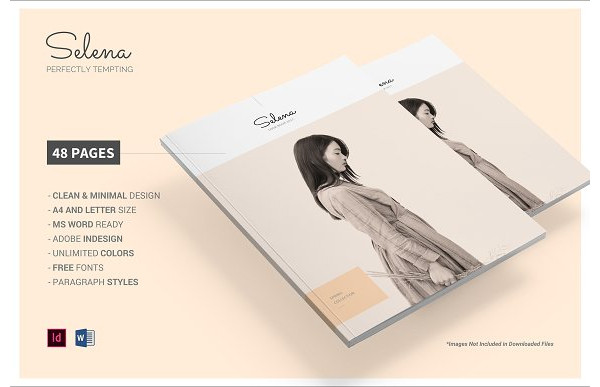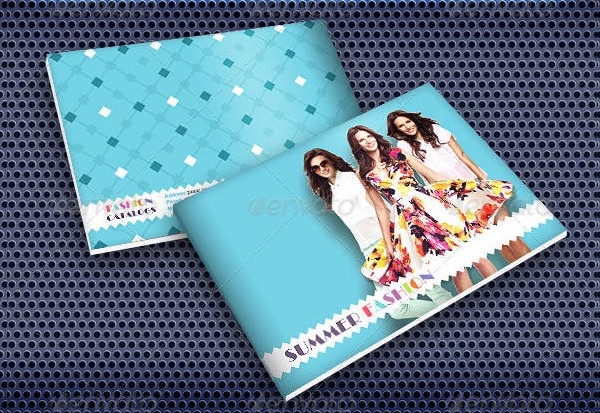10+ Clothing Catalog Examples to Download
Catalogs, believe it or not, are still a thing. Not only that, they are even a highly recommended tool for sellers to market their products to their customers. The advantage that catalogs offer is how they allow potential clients to shop in the comforts of their own home, even while cooking or enjoying a hot much-needed bubble bath. There will no longer be a need to take five hours out of your weekend to head to the mall to shop because you can simply squeeze that into your free time at home or at work. You may also see fashion catalog examples.
Catalogs have always held a special kind of bond with customers. Perhaps it’s because of the shiny, glossy paper usually used in making them, or the look of pretty dresses worn by just as attractive models makes one want to buy them, or maybe it’s because things, even clothes, simply look amazing, even artistic, in pictures that people can’t resist making a purchase. Whatever the reason may be, only one thing’s certain: catalogs still work. You may also see T-shirt catalog examples.
Fashion and Clothing Catalog Example

Clothing and Photography Catalog

Summer Clothing Fashion Catalog

Creating a Catalog: The Complete Guide
Learning how to design your own catalog is all about understanding the little trivialities that make up the whole picture. To help with that, let us talk about the tiny parts of a catalog. You may also see multipurpose catalog examples.
Why is a catalog important? A catalog is simply another tool that can be used by a brand to reintroduce and reinforce its identity to the public. Its job is similar to what a business card or a logo does. It’s an extension of the gigantic name sign often found in a store’s physical location. It will not only help people recognize you, if done right, it can make you unforgettable. You may also see real estate catalog examples.
Marketing specialists acknowledge a catalog’s ability to make a considerable difference in terms of sales. It is functional, and appealing at the same time, both elements that can be easily manipulated to work for the business’s advantage. You may also see sales catalogs.
In which formats can a catalog be created? Catalogs are always created digitally, since one would need a computer for designing it. But the finished product can also be released in printed form.
Print catalogs. Despite the advanced technology, and the rise of many marketing techniques, printed catalogs remain undefeated as being the world’s best sales tool because of its many advantages:
1. Constant brand exposure
Since a catalog is a physical object, it will be kept on a table or a desk where it’s readily available and accessible. It’s presence would mean that your brand is constantly exposed to your customers, and this is the most basic principle of advertising. You may also see product catalog examples.
2. User-friendliness
In comparison to its digital counterpart, a printed catalog is far easier to consult by people of any age. There will be no need for a fast internet connection, or a basic knowledge of computer use, or even of a gadget. With a printed catalog, one simply needs to pick it up from where it is, flip through its pages, and get to know the brand that it represents. You may also see toy catalog examples.
3. Readability
Printed catalogs, or basically everything printed, have the distinct advantage of being highly readable. If you’re reading the digital version of the catalog on an iPad, and you happen to click in the wrong place, chances are you’ll end up at a different page. Details and words may also appear smaller on screen, and zooming in and zooming out is such a tedious activity knowing that there is another less hassle alternative. You may also see travel catalog examples.
4. Quick search
A catalog is often made up of many pages. It’s natural to feel the need to bookmark one of them, old-school style.
Digital catalogs. Digital catalogs are catalogs created using digital tools, and since companies and stores nowadays digitize their products to make it easier to market and distribute them, these are often a great alternative to the usual paperback. It also helps one save from printing and distribution costs. Digital catalogs simply need to be uploaded to the Internet for the public to feast upon. However, aside from its cost-effectiveness, it doesn’t have a lot of advantages to printed catalogs. You may also see fashion catalog examples.
Fashionable Clothing Catalog Example

What are the parts of a catalog? Just like your regular book, a catalog also has different parts. There are the most basic ones, of course, such as the cover, the table of contents, and the back cover. Some parts are only present in catalogs if they are required. You may also see restaurant catalog examples.
- Cover (front cover). This is the front page of the catalog, the one we usually see when it is displayed in stores or on coffee tables. It often features the image of the catalog’s main issue for the month.
- Thumb index. A thumb index is a round cut-out in the pages of the catalog for easier reference.
- Introduction pages. These pages often include descriptions of the catalog and its content, and a few advertisements.
- Table of contents. This section contains chapters, sub-chapters, and page numbers. You may also see construction company catalog examples.
- Final pages.
- Back cover.
How do you organize a catalog? Organizing the information in a catalog can be difficult work. One must look at it the way a client would. Think: will the client look for certain products in every category in the catalog, or will he flip through every page? What approach will the client use in perusing the catalog? In most cases, it’s most useful to organize elements by category or by product attribute, such as price, color, or application. You may also see minimal brochures.
However, each catalog, depending on its use, purpose, and subject, must be organized differently. For example, medical catalogs are arranged alphabetically, but that order won’t work for a clothing catalog. Mixing the rules, or following less criteria is often more helpful. Use the best approach that can make the catalog’s every page more engaging to customers. You may also see service brochure examples.
Elements Involved in Making a Catalog
There are only three things you need to create a catalog: product data, images, and the catalog’s layout.
1. Product data
The product data includes codes, categories, subcategories, product name, descriptions, attributes, prices, and bar codes.
2. Images
Once all of the textual information are in your possession, start gathering the article images you need. You can even collect symbols or icons should they apply. Whatever visual element is necessary for you to effectively project the items and products you want. The images must be in the best quality to give your catalog a professional look. You may also see travel agency brochures.
3. Catalog layout
Now that you have both data and images, you can move on to the operative phase of creating a catalog: the layout creation. For this phase, you will need the help of an able graphic designer. He will be in charge of solidifying your visions and ideas about how the product information and images will be organized on the actual catalog’s surface. You may also see landscape brochure examples.
Outdoor Clothing Catalog Sample

Professional Clothing Catalog Example

What is the process involved in publishing a catalog? Once you have finalized the layout of the catalog, the publishing process, which is one of the most crucial steps, will begin. The publishing process will involve inserting the information, data, images, and layout into the catalog in a structured way. There are three options at your disposal for doing this:
1. Manual publishing
This option will involve copying and pasting each information and data manually from your source into the document. It usually takes a lot of time, weeks or months even. depending on how many articles or pages need to be created. Also, since humans are the ones who drive the process, it is 90% more prone to errors. A simple slip of the hand can already cause so much damage to the work. This is where machines are a better choice. You may also see wholesale catalog examples.
2. Automatic publishing
Automatic publishing refers to software that allows you to automatically import your product data from a database into the document you are creating. Which means we can say goodbye to good old copying and pasting. This option will require an in-house or an on premises software. Unfortunately, these software packages are quite costly, and the layouts are difficult to create. You may even need to pay for support service. There are also other disadvantages to using in-house software:
- Not all of your data files may be suitable for every software package. Each one needs to have its own kind of data file.
- The design process is pretty limited. The layouts are created using default grids only. Should you want to make changes to them, you will still need to follow software rules, given that what you need has already been implemented. You may also see recipe cookbook catalog examples.
- It can be difficult to learn how to use these programs since there isn’t much online documentation that can support them.
- You will have to pay to be trained for its use, which is often billed by the hour.
- Using this software has a sort of “use it or lose it” rule. If you only need to create a catalog twice a year, you might discover that you have forgotten the skills necessary for the function. If you only use it to recreate a catalog or to edit an old one, you will need a lot of time to remind yourself how to use the software. You may also see real estate agency brochures.
- The extensions of the created files belong to the software company, which means that the source file can only be viewed on the computer where the software is originally installed.
- Usually, only one or two people in a company are equipped with the necessary competency to man this software. Should the company lose these people, or should they change position, the ability will be lost from the company. You may also see interior design catalog examples.
- The cost for these packages is often very expensive. It can cost 15,000 to 25,000 euros, not including updates, licenses, and training.
3. Cloud publishing services
This option is much less expensive, the layouts are fully editable, and support service is already included in the fee you will pay. Cloud-based publishing software can also be used online. In fact, this software is so simple they can be accessed with common browsers like Chrome or Firefox. You may also see email branding designs.
Many companies have discovered that Cloud technology is a great alternative if you are looking for a way to cut your software costs, increase your product innovation, and improve support for your customers. It’s not only cheap, it’s also a great place for the automatic publishing software to improve itself. You may also see A4 brochure examples.
Fashion Clothing Look Book Catalog

Men’s Summer Clothing Catalog

Simply Apparel Clothing Catalog

How much does creating a catalog cost? We have finally arrived at the numbers involved in this business. Commonly, a 300-paged catalog made for the first time without an automatic system can cost from 10,000 to 20,000 euros. But the pricing will depend mainly on the complexity of the product, and the number of references it contains, such as the names, descriptions, and values it will use. You may also see portfolio catalog designs.
1. The printing phase
Once you have everything prepared, all there is left for you to do is to print it all out for the finished product. You might think this part is relatively easy after all that you’ve went through to create this final output, but finding the right printer isn’t as easy as it may sound. You may also see technology brochures.
It’s important to avoid skimping on the printer. The printing process is difficult, and many things can go wrong before you can get your hands on your actual catalog. You can either team up with a good agency or a professional to make sure that you execute this part right.
2. Low cost solutions
If the above printing option sounds too complex for your liking, there is also another alternative you can go for. Talk with local printers and online printing companies about your catalog needs. Choose a high-gloss printing for the cover page of your catalog, and use cheaper paper for the actual pages. You can even prepare the catalog’s layout in your own computer instead of paying somebody else to do it for you. You may also see interior design portfolio examples
You can save even more money if you use limited ink colors for printings. High-resolution black and white photographs will also help you get the costs down. If you are going for a minimalist or retro look, this might just work for your catalog. You can go for a smaller size catalog with only a few pages to save more.
Now that you understand exactly what a catalog means and what it is made of, you can now create your own. Use the gorgeous catalog design we have posted in this article to give you a boost toward designing your own. You may also see business catalog examples.


